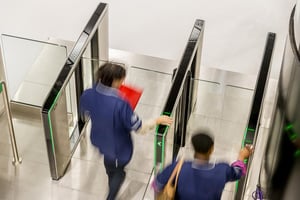Maintaining a secure entrance is an essential part of overall building security, and many enterprises are employing security officers to guard their entrances and exits, and to manage traffic flow. Hiring a security professional who is trained to secure an enterprise while being welcoming and helpful to tenants and guests can deter crime and provide peace of mind. In addition, security officers are your critical first responders, should something go wrong.
Why Security Guards, Alone, Are Not Enough
Yet, security officers can easily be distracted while executing daily responsibilities as commonplace as engaging visitors and employees. Alarm fatigue can also be a factor; if a guard repeatedly receives false alarms they can tune them out or turn them off. Thanks to the proliferation of smart phones, says research by Statistic Brain, the average attention span of an adult person is 8.25 seconds. That number is down from 12 seconds, which was the average attention span in the year 2000. While that may not necessarily apply to every member of your security team, it could potentially leave your enterprise open to unknown risks and an inability to mitigate those risks.
A complete risk mitigation strategy around your enterprise’s entrances and exits should consist of a balance between technology, education and manpower. It should encompass security officers and security entrances that work alongside each other for the ultimate in risk mitigation.
Selecting the Security Entrance Solution That Best Meets Your Needs
There are multiple types of security entrances for different applications, industries and levels of security. They all integrate easily with access control systems and most also work very well with biometric verification technologies to ensure the identity of the user. When researching which security entrance to employ, it’s important to first identify your goal. Are you looking for basic, supervised crowd control, an alarm when tailgating occurs, or, prevent tailgating and piggybacking from happening at all?
 Waist high turnstiles are a solid option for controlling high volumes of traffic, such as stadiums, public transit and university campuses. They should be monitored by professional security officers.
Waist high turnstiles are a solid option for controlling high volumes of traffic, such as stadiums, public transit and university campuses. They should be monitored by professional security officers.
Full height turnstiles are a true deterrent, as it is difficult-to-impossible to go over or under them. They are typically unmanned, yet if they are used in interior lobbies that lead directly into higher security areas, a professional security officer can effectively supervise their use.
Optical turnstiles can deter and detect, as they can sense movement during passage and sound an alarm if tailgating occurs. While optical turnstiles with barriers deter unauthorized entry, it is possible to tailgate behind an authorized user, so these turnstiles are most effective when they are used in conjunction with a well-trained security officer.
Security revolving doors and mantrap portals make it close to impossible to tailgate into your facility, with sensors that recognize shapes, size and volume and stop entry. They are often the entry solution of any company that is subject to mandatory regulations, and they are commonly used at employee-only entrances, in addition to any facility that requires two-factor authentication.
Integrating Security Officers and Security Entrances
Professional security officers are an essential component of a physical security plan, but should be considered one component in an integrated solution. Security entrances help ensure the best use of security officers’ physical presence to not only monitor activities, but also register visitors, train employees on proper security procedures and handle other critical tasks. Security entrances deter casual intrusion, accurately record entry transactions, never take a day off, can’t be distracted, won’t suffer from alarm fatigue and will always be alert and aware.
When deployed in combination with well-trained and professional security officers, security entrances create an added layer of physical security that is highly reliable with multiple check points, to ensure a secure work environment.

